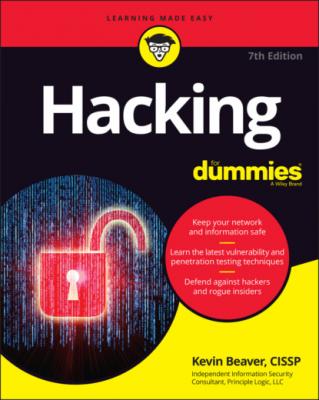Hacking For Dummies. Kevin Beaver
Чтение книги онлайн.
Читать онлайн книгу Hacking For Dummies - Kevin Beaver страница 13
 grown exponentially.
grown exponentially.
Nontechnical attacks
Exploits that involve manipulating people — your users and even you — are often the greatest vulnerability. Humans are trusting by nature, which can lead to social engineering exploits. Social engineering is exploiting the trusting nature of human beings to gain information — often via email phishing — for malicious purposes. With dramatic increases in the size of the remote workforce, social engineering has become an even greater threat, especially with more personal devices being used that are likely much less secure. Check out Chapter 6 for more information about social engineering and how to guard your systems and users against it.
Other common, effective attacks against information systems are physical. Hackers break into buildings, computer rooms, or other areas that contain critical information or property to steal computers, servers, and other valuable equipment. Physical attacks can also include dumpster diving — rummaging through trash cans and bins for intellectual property, passwords, network diagrams, and other information.
Network infrastructure attacks
Attacks on network infrastructures can be easy to accomplish because many networks can be reached from anywhere in the world via the Internet. Examples of network infrastructure attacks include the following:
Connecting to a network through an unsecured wireless access point attached behind a firewall
Exploiting weaknesses in network protocols, such as File Transfer Protocol (FTP) and Secure Sockets Layer (SSL)
Flooding a network with too many requests, creating denial of service (DoS) for legitimate requests
Installing a network analyzer on a network segment and capturing packets that travel across it, revealing confidential information in cleartext
Operating system attacks
Hacking an OS is a preferred method of the bad guys. OS attacks make up a large portion of attacks simply because every computer has an operating system. They are susceptible to many well-known exploits, including vulnerabilities that remain unpatched years later.
Occasionally, some OSes that tend to be more secure out of the box — such as the old-but-still-out-there Novell NetWare, OpenBSD, and IBM Series i — are attacked, and vulnerabilities turn up. But hackers tend to prefer attacking Windows, Linux, and macOS because they’re more widely used.
Here are some examples of attacks on operating systems:
Exploiting missing patches
Attacking built-in authentication systems
Breaking file system security
Installing ransomware to lock down the system to extort money or other assets
Cracking passwords and weak encryption implementations
Application and other specialized attacks
Applications take a lot of hits by hackers. Web applications and mobile apps, which are probably the most popular means of attack, are often beaten down. The following are examples of application attacks and related exploits that are often present on business networks:
Websites and applications are everywhere. Thanks to what’s called shadow IT, in which people in various areas of the business run and manage their own technology, website applications are in every corner of the internal network and out in the cloud. Unfortunately, many IT and security professionals are unaware of the presence of shadow IT and the risks it creates.
Mobile apps face increasing attacks, given their popularity in business settings. There are also rogue apps discovered on the app stores that can create challenges in your environment.
Unsecured files containing sensitive information are scattered across workstation and server shares as well as out into the cloud in places like Microsoft OneDrive and Google Drive. Database systems also contain numerous vulnerabilities that malicious users can exploit.
Following the Security Assessment Principles
Security professionals must carry out the same attacks against computer systems, physical controls, and people that malicious hackers do. (I introduce those attacks in the preceding section.) A security professional’s intent, however, is to highlight any associated weaknesses. Parts 2 through 5 of this book cover how you might proceed with these attacks in detail, along with specific countermeasures you can implement against attacks on your business.
To ensure that security testing is performed adequately and professionally, every security professional needs to follow a few basic tenets. The following sections introduce the important principles.
Working ethically
The word ethical in this context means working with high professional morals and values. Whether you’re performing security tests against your own systems or for someone who has hired you, everything you do must be aboveboard in support of the company’s goals, with no hidden agenda — just professionalism. Being ethical also means reporting all your findings, whether or not they may create political backlash. Don’t laugh; on numerous occasions, I’ve witnessed people brushing off security vulnerability findings because they didn’t want to rock the boat or to deal with difficult executives or vendors.
Trustworthiness is the ultimate tenet. It’s also the best way to get (and keep) people on your side in support of your security program. Misusing information and power is forbidden; that’s what the bad guys do, so let them be the ones who pay a fine or go to prison because of their poor choices.
Respecting privacy
Treat the information you gather with respect. All information you obtain during your testing — from web application flaws to clear text email passwords to personally identifiable information (PII) and beyond — must be kept private. Nothing good can come of snooping into confidential corporate information or employees’ or customers’ private lives.
Not crashing your systems
One of the biggest mistakes I’ve seen people make when trying to test their own